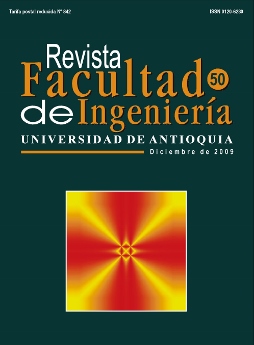Prototipo de sistema en lazo cerrado para administración de anestesia intravenosa
En este artículo se presenta el desarrollo de un sistema en lazo cerrado de administración de anestesia intravenosa. Para lograr esto se implementan diferentes subsistemas: un modelo multicompartimental de distribución de fármacos en el cuerpo humano, un algoritmo para determinar la curva de velocidades a las que debe infundirse el anestésico Propofol para obtener el efecto de anestesia general, un protocolo de comunicación para enviar el vector de velocidades a una bomba de infusión convencional y un lazo derealimentación para controlar todo el sistema a partir del índice bi-espectral que se utiliza como indicador de la profundidad de anestesia. El resultado final es un instrumento versátil, con prestaciones similares a las de equipos comerciales y con una interfaz interactiva, que facilita la operación por parte del anestesiólogo desde un computador convencional.
DOI:
https://doi.org/10.17533/udea.redin.14935Palabras clave:
Modelado de sistemas, sistemas de control, anestesia intravenosa, farmacocinética, bioinstrumentaciónResumen
En este artículo se presenta el desarrollo de un sistema en lazo cerrado de administración de anestesia intravenosa. Para lograr esto se implementan diferentes subsistemas: un modelo multicompartimental de distribución de fármacos en el cuerpo humano, un algoritmo para determinar la curva de velocidades a las que debe infundirse el anestésico Propofol para obtener el efecto de anestesia general, un protocolo de comunicación para enviar el vector de velocidades a una bomba de infusión convencional y un lazo derealimentación para controlar todo el sistema a partir del índice bi-espectral que se utiliza como indicador de la profundidad de anestesia. El resultado final es un instrumento versátil, con prestaciones similares a las de equipos comerciales y con una interfaz interactiva, que facilita la operación por parte del anestesiólogo desde un computador convencional.
Descargas
Citas
S. Schraag. “Theoretical basis of target controlled anaesthesia: history, concept and clinical perspectives”. Best Practice & Research Clinical Anaesthesiology. Vol. 15. 2001. pp. 1-17. DOI: https://doi.org/10.1053/bean.2001.0132
S. Milne, G. Kenny. “Target controlled infusions”. Current Anaesthesia and Critical Care. Vol. 9. 1998. pp. 74-179. DOI: https://doi.org/10.1016/S0953-7112(98)80051-3
X. Vivian, M. Leone. “Induction and maintenance of intravenous anaesthesia using target-controlled infusion systems”. Best Practice & Research Clinical Anaesthesiology. Vol. 15. 2001. pp. 19-33. DOI: https://doi.org/10.1053/bean.2001.0133
A. W. Paulsen. “Essential of anaesthesia delivery”. J. D. Bronzino (Editor) Biomedical Engineering Handbook. Ed. CRC Press LLC. Boca Raton. 2000. pp. 84.1-84.12.
G. Van Poucke, L. Brandon, S. Shafer. “Target Controlled Infusions: Targeting the Effect Site While Limiting Peak Plasma Concentration”. IEEE transactions on biomedical engineering. Vol. 51. 2004. pp 1869-1875. DOI: https://doi.org/10.1109/TBME.2004.827935
M. van den Nieuwenhuyze, F. Engbers, J. Vuyk, A. Burn. “Target-controlled infusion systems, role in anesthesia and analgesia”. Clinical pharmacokinetics. Vol. 38. 2000. pp 181-190. DOI: https://doi.org/10.2165/00003088-200038020-00003
M. Struys. P. Mortier. T. Smet. “Closed loops in anaesthesia”. Best Practice & Research Clinical Anaesthesiology Vol 20. 2006. pp. 211-220. DOI: https://doi.org/10.1016/j.bpa.2005.08.012
E. Mortier. M. Struys. “Monitoring the depth of anaesthesia using bispectral analysis and closed-loop controlled administration of Propofol”. Best Practice & Research Clinical Anaesthesiology. Vol. 15. 2001. pp. 83-96. DOI: https://doi.org/10.1053/bean.2000.0137
S. Shafer, K. Gregg. “Algorithm to rapidly achieve and maintain stable drug concentrations at the site of drug effect with a computer controlled infusion pump”. Journal of Pharmacokinetics and Biopharmaceutics. Vol. 20. 1992. pp. 147-169. DOI: https://doi.org/10.1007/BF01070999
R. Karba, D. Matko, B. Zupan, A. Mrhar, S. Primofi, E. F. Kozjek. “Usage of analog-hybrid and digital simulation in pharmacokinetics”. Electrotechnical conference. Vol 1. 1991. pp.763-766.
C. Hu. D. Horstman. S. Shafer.” Variability of Targetcontrolled Infusion Is Less Than the Variability after Bolus Injection”. Anesthesiology. Vol 102. 2005. pp. 639-645. DOI: https://doi.org/10.1097/00000542-200503000-00024
A. Barakat. N. Sutcliffe. M. Schwab.” Effect site concentration during propofol TCI sedation a comparison of sedation score with two pharmacokinetic models”. Anaesthesia. Vol 62. 2007. pp. 661-666. DOI: https://doi.org/10.1111/j.1365-2044.2007.05059.x
T. Schnider. C. Mint. S. Shafer. “The influence of age on propofol pharmacodynamics”. Anesthesiology. Vol. 90. 1999. pp.1502-1515. DOI: https://doi.org/10.1097/00000542-199906000-00003
L. Jiménez, F. Gutiérrez, T. Alvarez, L. Márquez, H. Mesa, A. Morales, A Noreña, F. Ramírez, F. Alvarez, E. Archila. Cirugia: Anestesiología. Universidad de Antioquia. Medellin. 1995.
Descargas
Publicado
Cómo citar
Número
Sección
Licencia
Derechos de autor 2018 Revista Facultad de Ingeniería

Esta obra está bajo una licencia internacional Creative Commons Atribución-NoComercial-CompartirIgual 4.0.
Los artículos disponibles en la Revista Facultad de Ingeniería, Universidad de Antioquia están bajo la licencia Creative Commons Attribution BY-NC-SA 4.0.
Eres libre de:
Compartir — copiar y redistribuir el material en cualquier medio o formato
Adaptar : remezclar, transformar y construir sobre el material.
Bajo los siguientes términos:
Reconocimiento : debe otorgar el crédito correspondiente , proporcionar un enlace a la licencia e indicar si se realizaron cambios . Puede hacerlo de cualquier manera razonable, pero no de ninguna manera que sugiera que el licenciante lo respalda a usted o su uso.
No comercial : no puede utilizar el material con fines comerciales .
Compartir igual : si remezcla, transforma o construye a partir del material, debe distribuir sus contribuciones bajo la misma licencia que el original.
El material publicado por la revista puede ser distribuido, copiado y exhibido por terceros si se dan los respectivos créditos a la revista, sin ningún costo. No se puede obtener ningún beneficio comercial y las obras derivadas tienen que estar bajo los mismos términos de licencia que el trabajo original.










 Twitter
Twitter